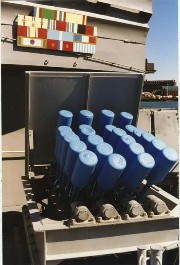Hedgehog (grenade weapon)
The Hedgehog ( English : "Igel") was an anti-submarine weapon and was developed by the British Royal Navy in the Second World War in response to the ever increasing German submarine threat and put into service in March 1943.
description
The hedgehog got its name because of its appearance. It was a simple, effective charge launcher and could be armed with 24 grenades, which were fired forward from the submarine hunter and, when immersed in the water, had an elliptical (Mark 10 Hedgehog) or round (Mark 11) area of about 40 meters Covered diameter. The projectiles used percussion fuses, so that only direct hits detonated these explosive devices . However, one or two hits were usually enough to sink a submarine.
history
The development of the Hedgehog goes back to the Canadian naval officer and chemist Charles Frederick Goodeve (1904–1980), who worked for the Directorate of Miscellaneous Weapons Development during World War II . Goodeve, who at the beginning of the war had worked on methods to reduce the magnetic signature of ship hulls to protect against sea mines , used the experience and experiments previously made with existing depth charges and developed the concept of inserting a number of small grenades into fire in a geometric pattern to increase the probability of hitting submarines.
In May 1941, a sample of the weapon was installed on the destroyer HMS Westcott , which carried out test runs on a wreck off Liverpool . From the end of the year began to install the weapon on escort ships. The first ship equipped with a Hedgehog launcher was the British frigate HMS Bayntun on March 12, 1943 . At the beginning of April 1943 the first encounters between escort ships and submarines equipped with the weapon. U 191 was sunk on April 23 of that year. Further successes of the weapon followed, although the Hedgehog could not be clearly identified as the clear cause of a sinking, since the missions were always in connection with conventionally dropped depth charges.
In Great Britain in 1942, building on the experience with the hedgehog, the heavier systems Squid and Limbo were developed. The US Navy also developed the Mousetrap launcher, which could fire four or eight projectiles which, unlike the Hedgehog, were propelled by rockets. In the Soviet Union, copies of the Hedgehog were produced under the designations MBU-200 and MBU-600 from 1949. The Hedgehog launcher remained in service with the US Navy for a long time and was not replaced by the target-guided ASROC until the 1960s .
Comparison of the Hedgehog with conventional depth charges
Advantages :
- The exact depth of the target did not need to be known.
- Since the weapon was fired forward from the attacking ship, ASDIC contact with the target could be maintained even while the bomb was being dropped. In the case of conventional depth charges , the ship had to drive over the submarine at full speed, which tore off the ASDIC contact. At this moment the commander of the submarine was able to maneuver his boat a little out of the danger zone by changing course or depth.
- In the event of unsuccessful attacks, the water was not stirred up and the use of the ASDIC for further attacks was not hindered.
Cons :
- Due to the lack of explosions in the event of unsuccessful attacks, the psychological effect on the submarine crew was less.
- There was no cumulative damage to the submarine if it was not hit directly.
Overall, the Hedgehog was found to be far more effective than conventional depth charges. About 25% of the submarines attacked with it were sunk, while depth charges only had a success rate of about 7%.
Technical specifications
- Effective range : 230–260 m
- Dead weight of the carriage : about 13 t
- Dead weight per launcher grenade: 30 kg
- Descent speed: about 7 m / s
- Rate of fire: one salvo per 3 min
- Load per launcher grenade: 14 kg
Web links
- Short description with pictures (English)

